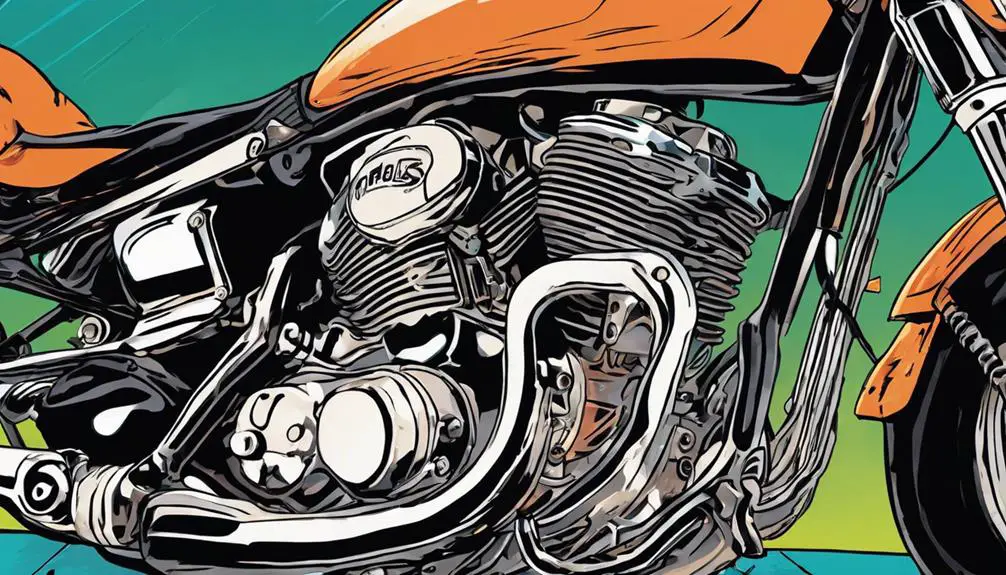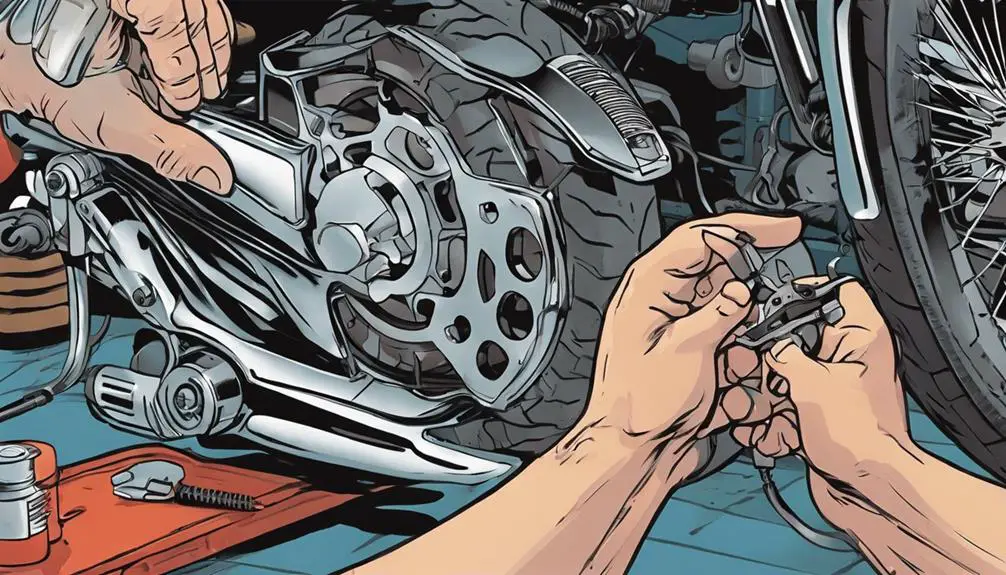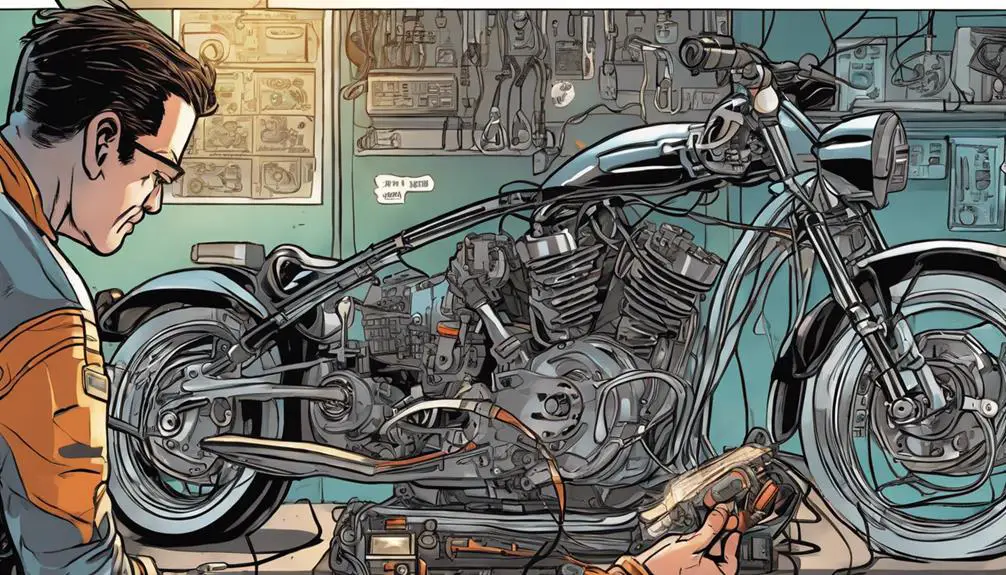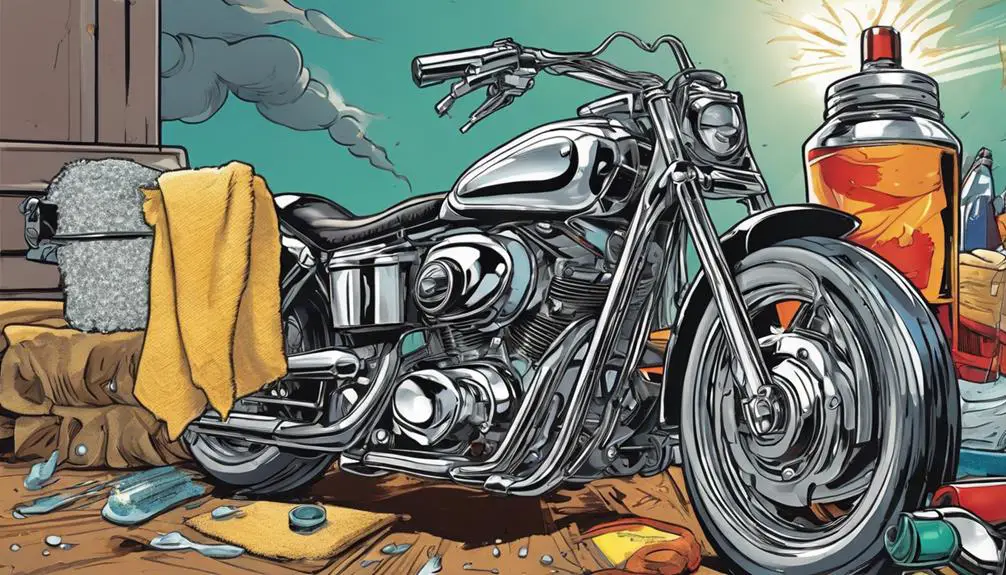When it comes to keeping your motorcycle running smoothly, you know that regular maintenance is key. You might think you're doing enough, but even small oversights can lead to bigger problems down the road. From oil changes to tire pressure checks, there are essential steps you need to take to guarantee your bike performs at its best. If you want to discover the vital tips that can save you time and money while enhancing your ride, stick around—there's more to uncover.
Key Takeaways
- Change the oil every 3,000 to 5,000 miles and replace the oil filter to ensure engine longevity and optimal performance.
- Regularly check and maintain tire pressure, tread depth, and look for any signs of wear to enhance safety and handling.
- Inspect brake pads and fluid levels before each ride to ensure reliable braking performance and prevent potential failures.
- Clean and lubricate the chain every 500 to 1,000 miles, checking for wear and tension to promote smooth operation.
Regular Oil Changes

To keep your motorcycle running smoothly, you should change the oil regularly. Fresh oil lubricates the engine, reduces wear, and keeps it cool, allowing your ride to release its full potential. When you neglect oil changes, you're risking performance and longevity, which isn't the kind of freedom you want on the open road.
Start by checking your owner's manual for the recommended oil change intervals. Generally, you'll want to change it every 3,000 to 5,000 miles, but factors like riding conditions can affect this. Don't forget to also replace the oil filter during each change; it's essential for trapping contaminants.
When you're ready, gather your tools and supplies. Drain the old oil, replace the filter, and pour in the new oil. This hands-on approach not only empowers you but also deepens your connection with your machine.
Tire Maintenance
Keeping your tires in top shape is essential for a safe ride.
You need to regularly check your tire pressure and inspect tread wear to guarantee peak performance.
Let's explore how these simple steps can make a big difference in your motorcycle maintenance routine.
Tire Pressure Monitoring
Regularly checking your motorcycle's tire pressure is essential for ideal performance and safety on the road. Properly inflated tires not only enhance your bike's handling but also improve fuel efficiency, letting you roam free without unnecessary stops.
When your tires are under-inflated, you risk poor grip and increased wear, which can lead to a loss of control and an unwanted sense of confinement. To stay liberated on your rides, invest in a reliable tire pressure gauge.
Check your tire pressure before every ride, especially on long journeys. Most motorcycles have a recommended pressure range listed on the tire or in your owner's manual. It's vital to measure when the tires are cold for the most accurate reading.
If you find the pressure is low, don't hesitate to add air. Many gas stations have air pumps, but you can also use a portable compressor for convenience.
Tread Wear Inspection
While maintaining proper tire pressure is important, inspecting tread wear is equally essential for your motorcycle's safety and performance.
When you hit the road, your tires are your only contact with the asphalt, so you need to guarantee they're in top shape. Start by checking the tread depth. Use the penny test—insert a penny into the groove with Lincoln's head facing down. If you can see all of Lincoln's head, it's time to replace the tire.
Next, look for uneven wear patterns. This can indicate misalignment or improper inflation. If you see bald spots, cracks, or blisters, don't ignore them; these could lead to blowouts. Make it a habit to inspect your tires before every ride, ensuring you're ready to embrace the freedom of the open road.
Lastly, remember to rotate your tires regularly, as this helps them wear evenly and prolongs their lifespan. Keeping your tread in check isn't just about maintenance; it's about riding with confidence and liberating your spirit.
Brake System Checks

You should perform brake system checks frequently to verify your motorcycle stops safely and effectively. Start by inspecting the brake pads. Worn pads can greatly reduce your stopping power, so replace them if they're less than a quarter-inch thick.
Next, check the brake fluid level in the reservoir. If it's low, top it off with the recommended fluid type, but don't forget to look for leaks in the lines or around the calipers.
Also, examine the brake lines for any signs of wear or damage. Frayed or cracked lines can lead to catastrophic failures when you need to stop most.
Don't overlook the brake rotors; they should be smooth and free of any warping. If you notice any grooves or a considerable amount of rust, it's time to replace them.
Lastly, test your brakes before hitting the road. Squeeze the lever or pedal gently and verify they engage smoothly without any grinding or squeaking noises.
Regular brake system checks not only enhance your safety but also empower you to enjoy every ride with confidence. Freedom on two wheels starts with knowing your brakes are reliable!
Chain and Sprocket Care
Taking care of your motorcycle's chain and sprockets is essential for smooth performance.
You'll want to establish a regular cleaning schedule, use proper lubrication techniques, and check for wear and tension regularly.
Regular Cleaning Schedule
Establishing a regular cleaning schedule for your motorcycle's chain and sprockets not only extends their lifespan but also enhances overall performance. When you commit to this routine, you empower your ride to achieve peak efficiency. Aim to clean your chain and sprockets every 500 to 1,000 miles, or after every ride in harsh conditions.
Start by gathering your tools—cleaning solution, a brush, and a rag. As you scrub away dirt and grime, you're liberating your bike from unnecessary wear and tear. Pay close attention to the sprockets, as they're essential for power transfer. A clean chain guarantees smooth engagement, allowing you to feel the freedom of the open road without hesitation.
Remember to inspect for any signs of damage or excessive wear. Identifying issues early can save you from costly repairs down the line. By embracing this cleaning ritual, you're not just maintaining your motorcycle; you're nurturing a bond with your machine that enhances every ride.
Proper Lubrication Techniques
Proper lubrication is essential for maintaining the health of your motorcycle's chain and sprockets, ensuring smooth operation and reducing wear. To keep everything running smoothly, start by selecting a high-quality chain lubricant that suits your bike's type and riding conditions.
Before applying the lubricant, clean the chain to remove dirt and grime. Use a dedicated chain cleaner and a brush to scrub away any debris, then wipe the chain dry. This step's vital, as dirt can grind against the metal, leading to premature wear.
Once the chain's clean, apply the lubricant evenly. Rotate the wheel as you spray or apply the lube, ensuring full coverage of the chain links and rollers. Aim for the inside of the chain, as this'll help distribute the lubricant as you ride.
After application, allow the lubricant to sit for a few minutes to penetrate deeply. Wipe off any excess to prevent dirt accumulation.
Depending on your riding habits, check and lubricate your chain every 300 to 600 miles. Regular maintenance will keep your motorcycle's chain and sprockets in top shape, giving you the freedom to ride without worry.
Wear and Tension Checks
Regularly checking the wear and tension of your motorcycle's chain and sprockets is essential for ensuring ideal performance and safety on the road. A loose or worn chain can lead to poor acceleration, reduced handling, and even serious accidents.
Start by inspecting your chain for signs of wear, such as rust or stiff links. If you notice any issues, it's time for a replacement.
Next, check the tension. You want it neither too tight nor too loose. A good rule of thumb is to have about an inch of play in the chain. If it's too tight, it'll wear out faster and strain your sprockets; too loose, and it could derail while you're riding.
Don't forget to also inspect your sprockets for signs of wear, such as hooked teeth or warping. If you see these, it's vital to replace them along with your chain.
Regular maintenance not only keeps your ride smooth but also empowers you to enjoy the freedom of the open road without worry. So, grab your tools, embrace the journey, and keep that chain in check for a thrilling ride ahead!
Electrical System Inspection

Inspecting your motorcycle's electrical system is essential for guaranteeing reliable performance and safety on the road.
Start by checking the battery. Look for corrosion around terminals and verify connections are tight. A clean, charged battery is your lifeline, so consider testing the voltage; it should read around 12.6 volts when fully charged.
Next, examine the wiring. Look for frayed or damaged wires, as they can lead to shorts and unexpected failures. Don't forget to check the fuses; a blown fuse can interrupt power to critical components.
Now, take a moment to inspect your lights. Confirm all indicators, headlights, and brake lights are functioning. Not only does this keep you visible, but it also enhances your freedom on the open road.
Lastly, check the ignition system. Make sure the spark plugs are clean and properly gapped, as this affects your engine's performance.
Regularly inspecting these components prevents issues that could limit your ride or, worse, leave you stranded. Embrace this maintenance ritual as part of your journey, guaranteeing your motorcycle remains a symbol of freedom and adventure.
Suspension Adjustments
Adjust your motorcycle's suspension to enhance handling and comfort, ensuring you tackle every ride with confidence and ease. A well-tuned suspension can transform your experience, making each twist and turn feel liberating. Start by checking your owner's manual for specific settings related to your bike's weight and riding style.
First, adjust the preload to accommodate your weight and any gear you carry. This controls the bike's sag and helps maintain ideal contact with the road. If you're riding solo or loaded with a passenger, tweak it accordingly to prevent bottoming out or excessive stiffness.
Next, fine-tune the compression and rebound damping. Compression controls how the suspension absorbs bumps, while rebound affects how quickly it returns to its original position. Experiment with these settings to find a balance that suits your riding style—whether you crave a softer ride for cruising or a stiffer setup for aggressive cornering.
Don't hesitate to test multiple configurations and see how they impact your ride. The goal is to create a seamless connection between you and the road, allowing you to enjoy the freedom that comes with mastery over your machine. Your motorcycle's suspension is your ally—treat it right, and it will reward you.
Cleaning and Detailing

To keep your motorcycle looking sharp and performing at its best, make cleaning and detailing a routine part of your maintenance schedule. Regular cleaning not only enhances your ride's appearance but also helps prevent rust, corrosion, and grime build-up that can affect performance.
Start with a gentle wash using a dedicated motorcycle cleaner and soft sponge; avoid harsh chemicals that can damage the finish. Don't forget to clean the wheels and tires, as they often collect debris. A good tire cleaner can bring out their shine and improve grip. After washing, dry your bike thoroughly to prevent water spots.
For detailing, consider applying a high-quality wax or sealant to protect the paint and keep it looking fresh. Pay attention to the chain, too; keep it clean and lubricated for a smooth ride. Use a chain cleaner and follow up with a suitable lubricant.
Frequently Asked Questions
How Often Should I Wash My Motorcycle?
You should wash your motorcycle every couple of weeks, or more often if you ride in harsh conditions.
Dirt, salt, and grime can build up, affecting both its appearance and performance.
Regular washes not only keep it looking sharp but also help you spot any potential issues early.
So, grab your soap and water, and give it some love—your freedom machine deserves it!
Keep that ride clean and ready for the open road!
What Types of Motorcycle Covers Are Best?
You might think any cover will do, but choosing the right one's essential for protecting your bike.
Look for waterproof, breathable materials that prevent moisture buildup. A snug fit is important, too, so it won't flap in the wind.
Consider UV-resistant options if you park outside often, as they shield your paint and finish.
Investing in a quality cover means your motorcycle stays safe and ready for your next adventure, rain or shine!
Can I Use Car Products on My Motorcycle?
You might be tempted to use car products on your motorcycle, but it's not always a good idea.
Car products often contain chemicals that can harm your bike's finish or components.
Instead, look for motorcycle-specific products designed for your ride's unique needs.
These will help keep your machine running smoothly and looking sharp.
Trust me, your bike will thank you for it, and you'll feel the difference in performance and longevity.
How Do I Store My Motorcycle for Winter?
When winter's chill hits, you'll want to store your motorcycle properly to keep it in top shape.
Start by cleaning it thoroughly to remove dirt and grime.
Fill the gas tank and add fuel stabilizer to prevent gumming.
Disconnect the battery and keep it charged.
Cover your bike with a breathable cover to protect it from dust and moisture.
What Should I Do if My Motorcycle Won't Start?
If your motorcycle won't start, don't panic.
First, check the battery; loose connections or a dead battery could be the culprit.
Make certain there's fuel in the tank, and inspect the fuel lines for blockages.
Listen for unusual sounds when you hit the ignition—if it clicks, that's a sign the battery needs a boost.
Finally, check the kill switch; it might just be in the wrong position.
You've got this!
Conclusion
By keeping your motorcycle in top shape, you'll enjoy an exhilarating ride today and a reliable companion for tomorrow.
Regular oil changes guarantee smooth performance, while proper tire maintenance keeps you safe on the road.
A well-inspected brake system offers peace of mind, and a clean bike shines like a star.
Remember, a little effort goes a long way—your motorcycle deserves it!
So, embrace the joy of maintenance, and hit the road with confidence and style.